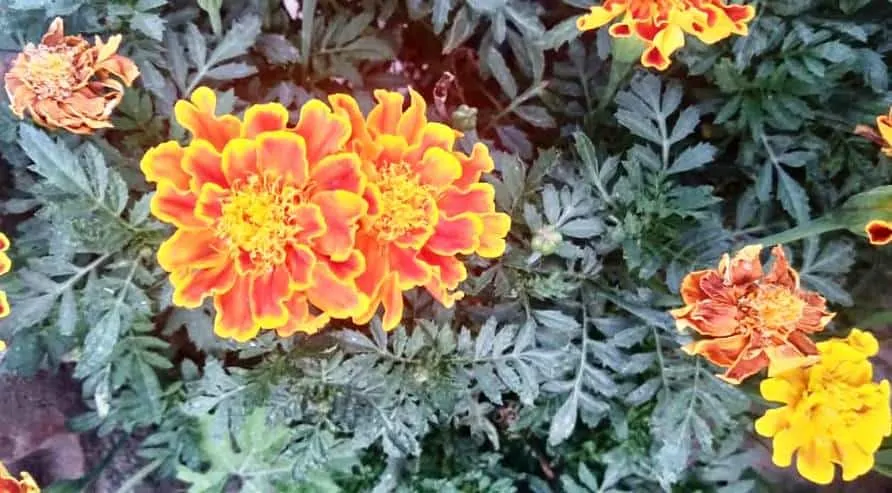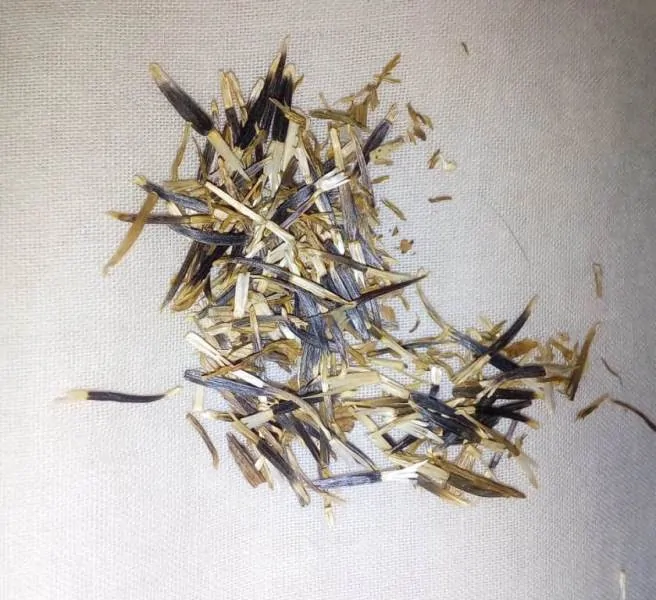Marigold is a very attractive flower and it blooms in bunches. Most varieties of marigold form bushes that results in multiple flowers together. These bushes may contain one or two and sometimes even more than 30 branches. These branches support the flower growth in the cost of nutrients present in the soil. If your plant is in a small pot then the number of branches directly affects the quality of the flower. So to keep plants healthy, especially in summer I prefer to deadhead marigolds.
What is a deadheading? Cutting off used or spent flowers or dead and decaying branches is known as Deadheading. Dead branches and spent flowers are not very good for plant growth and visuals. So removing them is necessary for healthy plant growth.
Should I deadhead my marigolds?
In nature plants care for them, we don’t need to clean or prune them. But in the home or kitchen garden, the green bushy plant is more favorable. We all like a fresh look for our plants and being fresh means new green leaves and bright flowers.
So the question rises- should I deadhead my marigolds? Yes, you definitely should cut off all the drying leaves, branches as well as flowers whenever necessary. It will help the plant to grow new branches and new branches mean new flowers.
Deadheading not only keeps the plants clean, but it also reduces the stress on soil and the plant for nutrients. Unnecessary growth also attracts bugs and no bug is good for your plants.
So whenever old flowers start drying and turning brown, deadheading is necessary. If any leaves are curling or wilting then you should cut them off immediately.
Check out our latest post: How to Grow Marigolds?
The ultimate answer to this question
Yes, it’s completely up to you, It will depend on your decision. Many expert debates that it is necessary to deadhead marigold. In my opinion, Deadheading helps me a lot in keeping my garden green since my childhood.
Marigolds especially bloom better when the plant is clean and green. So I can say it is a good practice to keep your plants green and healthy by deadheading old flowers and branches.
When Should I deadhead my marigold?
Now that we are aware of the importance of deadheading, it is better to ask when to deadhead marigolds. Deadheading marigolds should be done especially in the early morning and late evening when the sun is low. High heat may damage the branches being deadheaded. So it is important to understand that plants should not be placed in direct heat for at least 2-3 days after deadheading. Watering is a must to help regrowth of new branches.
How to Deadhead Marigold?
Deadheading is very important and pretty much essential in summer. It is the time when the plants have maximum bloom and more flowers mean more dry flowers, branches, and leaves. Removing them is necessary for healthy growth. In winter it is not the case though to reduce the stress these marigold needs deadheading in winter. It is so because flowering is low in winter but plant outgrowth is high. It will gain height with very few branches. To encourage strong healthy branch growth, marigold plants should also be pruned in winter.
Steps to Deadhead Marigold
Deadheading marigold requires mostly three important steps or just care procedures. The first one is the care before deadheading then the process of deadheading and aftercare for deadheading. To effectively deadhead your marigolds you can use several tools and gardening equipment. These tools not only make your job easy but also keeps your garden clean and attractive.
Tools I use to Deadhead marigolds
- Pair of scissors, especially the small ones. I generally prefer scissors in place of any pruner because marigold is a soft-stem plant and a pair of scissors are delicate to them.
- A sharp Knife, Though Scissors are better sometimes a good quality sharp knife will do the job for you.
- A good quality Pruner or cutter, Yes whether you believe it or not a pruner is a perfect tool for cutting any kind of stem. It is better to use on hardwood stems but you can use it on any plant. If using on marigolds, always take care of the green stems, don’t over-prune or cut the branches.
- Finally, the best tool is always your own- hands. Yes believe it, I prefer pinching individual dead and drying flowers with my hands instead of any mechanical tools.
Steps before Deadheading
It is important to disinfect the tools like a pair of scissors or knife with an appropriate disinfectant before deadheading the plant. Disinfecting the tools helps in preventing any fungus or bacterial infection in marigold plants. You can either use any chemical disinfectant or any organic fungicide along with sterilizing the tools in boiling water. If you are sure that your tools are free from any fungus or bacteria then you can skip this step. I won’t recommend ignoring this step.
Points to Remember: –
The time of deadheading is very important. You should never prune or deadhead any plant- not only marigolds in mid-day or noon time when the sun is high and direct over the heads. This may lead to severe leaf burn and ultimately your plant may degrade. So the best time for pruning any plant is in the evening when the sun has set and the temperature is low.
Related article: How to harvest marigold seeds?
Also, you should not prune or deadhead any of your plants in frost-like conditions, especially in the harsh winter season. This is the time when plants are fighting the climatic condition just to keep alive. If you prune them off probably they will never grow back again.
Steps during Deadheading Marigold
- Look out for flowers and branches that are drying. They are easy to spot, just give a thorough look for brown faded flowers.
- Check for flowers with dry petals and if the size is reduced and has any brown base leaves.
- Check for any branches or leaves infected with fungus. This can be identified by irregular leaf shape, curling or wilting of leaves, and any white powdery deposit beneath the leaves.
- Cut off the infected branches from the base node. It will prevent the infection from spreading. Don’t leave the branch intact if multiple signs of infection are identified.
- Cut the spent flower just below its two base leaves. This is quite simple and should be done periodically throughout the summer.
Steps after Deadheading Marigold
After deadheading, try to keep the marigold plant in a semi-shaded place. partial Sunlight will prevent the leaves from burning in the daytime. Water the plant appropriately to help faster regrowth. Although never keep the roots waterlogged else they will rot.
After keeping the plants in shade for a few days move them back into direct sunlight. This will initiate faster blooming in marigolds. Direct sunlight is required for blooming in marigolds. These plants cannot bloom in shade properly. In the next few days, your marigold will again be full of fresh leaves and new blossoms.
Related Questions: –
Also read: When do marigolds bloom?
Should you deadhead immediately after planting the marigold?
It depends on whether the plant is big enough to stand deadhead by itself or not. Generally, the new plant should not be deadheaded, old leaves will dry and shed by themselves and you need not rip them off the plant.
If you are repotting the marigold plant and your plant has some dead branches or old flowers then you should cut them off but with full care. Repotting plants is very stressful for the roots and if you cut or prune the branches unnecessarily then it will increase the stress.
Can I plant marigolds from deadheaded blossoms?
Yes, you definitely can grow new plants if the blossoms you collected were fully mature. This means if the seeds are nearly black in color at the time of deadheading and the flower was drying by itself then it is very likely to grow new healthy plants with these flowers with proper care.
Can I plant marigolds from deadheaded branches?
No, you certainly shouldn’t use deadheaded branches for growing the marigold. Deadheading is certainly similar to pruning but not the same at all. Dead or decaying branches with any fungal infection are generally deadheaded whereas Pruning is done for fresh green branches good for planting. Branches being Deadheaded are certainly not fit for growing new plants. These are mostly dry branches with the least possibility of healthy growth.
Can I deadhead if my marigold won’t bloom?
Yes, you can deadhead marigold plants if they don’t bloom. Sometimes pruning the plant help in developing fresh meristems that grow to form new buds. So if your plant is bushy and green but not blooming then you can prune the tips and water it properly. Also, try moving the plant to direct sunlight if possible- It will increase the chances of blooming marigolds.
Is Deadheading Necessary for caring Marigolds?
It is very important. Deadheading is an essential part of marigold plant care. It not only keeps plants looking green but also reduces the unnecessary load of nutrients on the soil by the dead branches and flowers. It is a good and easy way to keep the marigold bush healthy, especially the french, African, and Mexican marigolds.
French marigold is very resistant to heat and forms a large number of flowers in summer. These plants require heavy deadheading throughout summer. If you plant African marigolds for bigger flowers and it is in your garden or in pots then deadheading is a must. It should be done periodically to remove the heavy load from branches.




Do you need to pinch out the tops of the Marigold to get a more bushy plant?
Yes, Pinching in the early days (2nd-3rd month) definitely works in making a bushier plant. But don’t pinch after the buds are ready to bloom. Buds should only be removed if you want a few big blooms instead of many little ones.